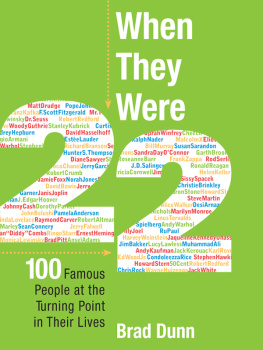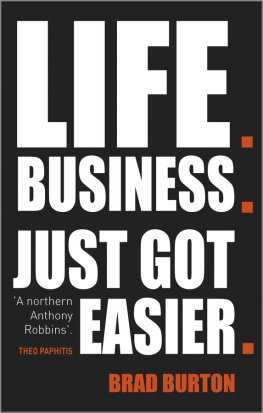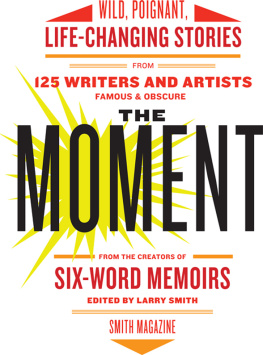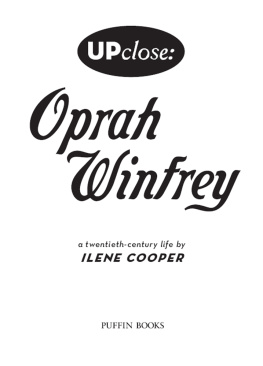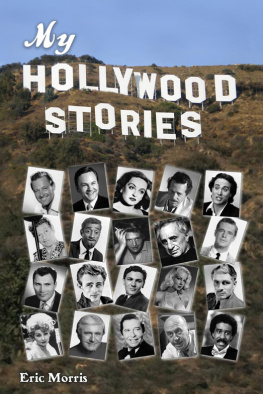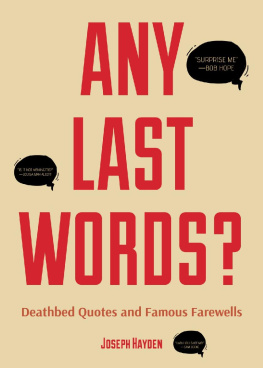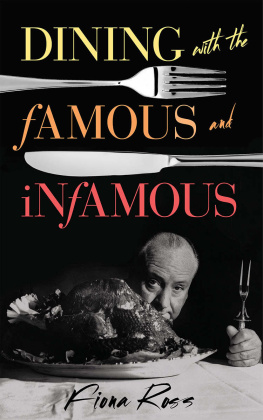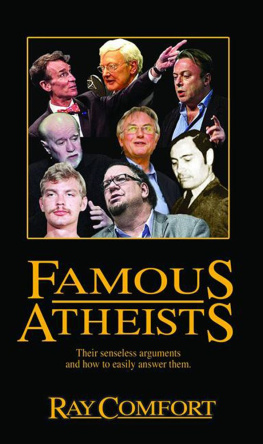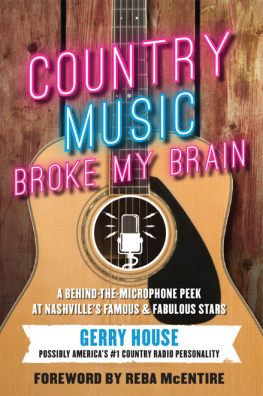
Also by Brad Dunn
New York: The Unknown City
When They Were 22 copyright 2006 by Brad Dunn. All rights reserved. No part of this book may be used or reproduced in any manner whatsoever without written permission except in the case of reprints in the context of reviews. For information, write Andrews McMeel Publishing, an Andrews McMeel Universal company, 1130 Walnut Street, Kansas City, Missouri 64106.
Library of Congress Cataloging-in-Publication Data
www.andrewsmcmeel.com
Dunn, Brad, 1973
When they were 22 : 100 famous people at the turning point in their lives
/ Brad Dunn.
p. cm.
Includes bibliographical references.
E-ISBN: 978-0-7407-8681-5
1. CelebritiesBiography. 2. Biography20th century. 3. Life change events. I. Title.
CT120.D855 2006
920.00904dc22
[B]
2005057170
Design: Jim Walsh, Kansas City, Missouri
Cover Design: Lee Fukui
Author Photo: Della Rocca
ATTENTION: SCHOOLS AND BUSINESSES
Andrews McMeel books are available at quantity discounts with bulk purchase for educational, business, or sales promotional use.
For information, please write to: Special Sales Department, Andrews McMeel Publishing, 1130 Walnut Street, Kansas City, Missouri 64106.
For Amy, with love and stroller
Contents
Introduction
Most of us can point to one or two times in our lives when everything changed, when a single decision or chance encounter forever altered the future.
It could be a romance (as it was for F. Scott Fitzgerald), a fender bender (Marilyn Monroe), an acid trip (Robert Crumb), or a series of electroshock treatments (Larry Flynt). Jane Goodalls life was changed by a trip to Africa; for Harrison Ford, it was a trip to the mens room.
These pivotal moments are the most fascinating part of any biography because they reveal the unexpected turning points in life and lay bare the incredible process of human destiny.
Where a biography tracks one life through many moments, this book follows many lives through one moment. These are portraits of famous peopleactors, politicians, writers, criminals, porn starsat the most pivotal time in their lives.
If you look for that turning point across a spectrum of personalities, youll find a recurring theme: age 22. No other age contains more risks, more big decisions, more random strokes of fate. Like Fitzgerald, Flynt, and Ford, more people experience life-altering changes at 22 than at any other point in their lives.
Of course, some find their callings much earlier. Albert Einstein is not in this book. Neither is Bob Dylan, or Katharine Hepburn, or Michael Jordan. They all discovered their talents at a younger age and by 22 were developing another theorem, recording another album, starring in another movie, or signing another contract with the Chicago Bulls.
But for the people in this book, and for most of us, the path was not so clear so early. Instead, we see Bill Murray studying to become a surgeon and Pamela Anderson teaching an aerobics class. Matt Drudge worked in a gift shop; Jack White was an upholsterer. Yet, all of them share one thing: a personal metamorphosis at 22.
If youve been there, youll remember what that age is like: filled with excitement and uncertainty, vague ambitions struggling to find definition. Endless possibilities line the horizonenough to inspire you or to paralyze you with indecision.
If you havent reached that age yet, the stories in this book will give you a glimpse of the vast and unpredictable roads that lie ahead.
Ronald Reagan found success after a string of failures: At twenty-two Id achieved my dream: I was a sports announcer. If I had stopped there, I believe I would have been happy the rest of my life, he said. Oprah Winfrey found failure after a string of successes: I was called in and put on the edge of being fired I was devastated. I was twenty-two and embarrassed because I had never failed before, she recalled. Yet, for both of them, 22 marked a radical turning point in their lives.
Some people discover a new world at that age: Woody Guthrie, Raquel Welch, and Brad Pitt all packed up for Los Angeles. Others have to hit rock bottom first: Billy Joel tried to kill himself by drinking a bottle of furniture polish.
These are portraits of young people at the crossroads, making bold decisions, suffering early defeats, reveling in unexpected triumphs. Some are in a rut. Some are hell-bent on success. Some get lucky. Some get blindsided by misfortune.
But theyre in this book because they ultimately did something remarkable with their lives, and to understand their story, you only need to glimpse them at their most defining moment: age 22.
Join the Club
Ansel Adams turned 22 on February 20, 1924.
One of the most celebrated photographers in the history of the camera grew up hoping to make a living using his ear, not his eye.
Born and raised in San Francisco, Ansel Adams taught himself to play piano at age 12 and dreamed of becoming a concert performer. He even quit school to pursue music full-time. In his late teens, however, he made his first trip to Yosemite National Park and was awestruck by the grandeur and beauty of the Sierra Nevada. He returned home and begged his parents to get him a camera so he could capture all the outdoor splendors hed seen. They bought him one, and Adamss time on the piano bench rapidly declined.
Toting his Kodak No. 1 Box Brownie, Adams hiked, camped, climbed, and snapped hundreds of photographs of the park, which he used as records of his journeys. He joined the Sierra Club and spent four summers as the keeper of its LeConte Memorial Lodge. The club published regular bulletins, and in 1924 Adams saw a chance to turn his photography pastime into professional work.
The summer after his 22nd birthday, he set up camp in his makeshift darkroom and created his first significant photographs. His dedication paid off and spurred a major turning point in his life. The Sierra Club agreed to publish several of his pictures in its bulletin that fall. The photos received instant and widespread praise for their stark contrast and mesmerizing depth. Adams had found his calling.
He became a regular contributor to the bulletin until 1928, when he had accumulated enough work to open his own exhibition at the Sierra Clubs headquarters in San Francisco. The show garnered national attention and inspired him to devote the rest of his life to photography and conservation.
See Jamie Foxx, page 44, and Condoleezza Rice, page 119.
Champ Revamped
Muhammad Ali turned 22 on January 17, 1964.
Perhaps the greatest athlete of the twentieth century, the boxer born as Cassius Clay not only became heavyweight champion of the world at age 22 but he also adopted a new religion and reinvented his identity.
After winning a gold medal in the 1960 Summer Olympics in Rome, Clay took his unorthodox boxing styleand penchant for self-promotionto the professional circuit. Though the Louisville, Kentucky, native was an underachiever in school, he proved to be extremely intelligent and quick-witted with reporters. He soon became known as the Louisville Lip for his rhyming taunts and outrageous boasts. I am the greatest, he said. Not only do I knock em out, I pick the round!

